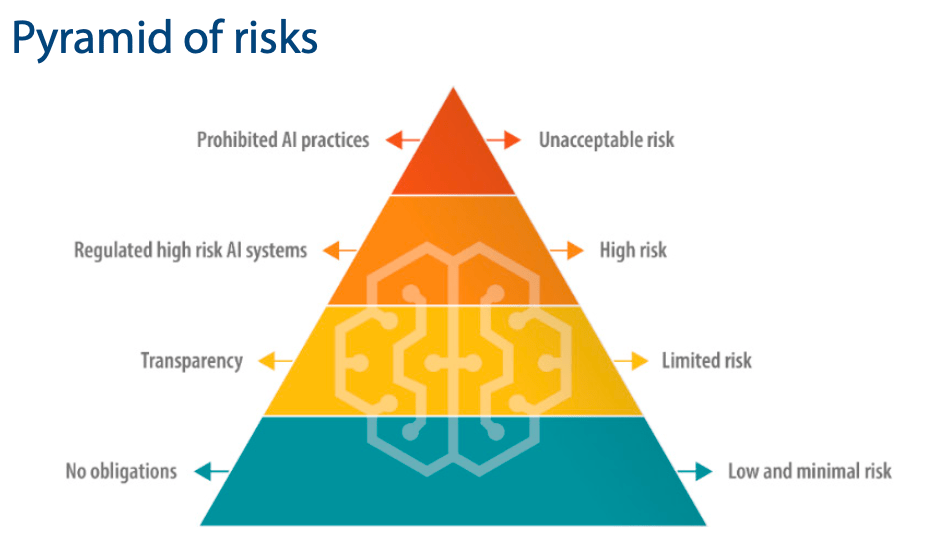GenAI, It’s Happening Now
AI is all around us, and the rise of Generative AI, also known as GenAI, is increasingly being discussed. Numerous articles have been written about it, but one pressing question remains: Is GenAI already usable within my business, or is it just a fun gadget?
In this blog post, we explore the potential of GenAI. Together, we investigate the current possibilities, how we already use GenAI for our clients and the associated risks. The goal is to inspire you to think about the impact of GenAI on your business and your daily activities and to provide you with practical tools. Together, we can explore how you can benefit from GenAI.
DALL E created an advertisement poster that convinces business people to start using Generative AI.
GenAI, a short introduction
GenAI is the abbreviation for Generative Artificial Intelligence. AI is a broad field where computers perform tasks we do not want or cannot do due to size, speed, or accuracy. Much of AI is used to find data patterns to make predictions and group or compare data. AI has been applied for decades. Consumers came into contact with it through chess computers, voice assistants, self-driving cars, and much more.
Generative Artificial Intelligence
Generative AI is a particular area of AI where a system converts questions or commands into new data or content. The general public came into contact with GenAI when the company OpenAI launched the product ChatGPT at the end of 2022. ChatGPT allowed us to generate larger pieces of text and create summaries. It became even more interesting when people started using it to go from one language to another. You could even go from an ordinary language to a programming language. This made it possible to write an SQL query based on natural language.
Review all invoices from the past month, group them by product categories, and calculate the total revenue and the average revenue per category.
Besides text and, thereby, programming languages, the next step was the generation of imagery. By utilising the technology of Stable Diffusion, it became possible to create visual material. Tools such as DALL-E and Midjourney can create an image based on your question or command. The image above this article was also generated using a prompt.
Create an advertisement poster that convinces business people to start using Generative AI, do NOT use text characters in the image.

In addition to static images, there are possibilities to generate moving images. This generation of imagery is now also known as Deepfakes. I have also experimented with it myself; suddenly, I became a rugged cowboy from the movie The Good, the Bad, and the Ugly.
All this technology is also finding its way into the business world. In the next part of this blog, we look at applications and the possible consequences of these applications for your work.
Applications of GenAI in a Business Context
Within the business world, GenAI is received differently. Many companies need a strategy for using tools like ChatGPT. This leads to uncontrolled growth within a company, making it unclear who uses it. Let alone that everyone understands the potential risks, for example, which data is or is not used to train the model better. This poses the risk that private data may become available through the model. Proper use of GenAI tools does provide a performance boost to employees. If we, for now, forget about the risks for a moment and focus primarily on the possibilities, what are the typical applications we encounter?
Customer contact with Large Language Models
Consider the initial contact with customers through a chatbot and answering the phone using voice technology. Those recordings with ‘press option 1, press option 3, press the hash key’ can be replaced by an AI Bot that listens to the question and converses with a person on the phone. If the bot can’t handle it, or if the person doesn’t want to talk to a bot, the person only needs to indicate this, and they will be transferred to a natural person instead of the bot. For the company, this means flexibility and not spending time developing such an option menu for the phone. This is possible with tools like OpenAI’s Whisper and Elevenlabs.
By leveraging the capacity of Large Language Models, you can engage in different forms of interaction with your users. Imagine you are a company offering people an unforgettable vacation experience. Then, you can let your users search and filter by choosing a country, type of vacation, number of people, and many other filter options. Alternatively, you can start a conversation with them through chat. Let them describe the kind of vacation they want. You can create an intermediary step by automatically selecting filters based on the text so the user can adjust.
I want to vacation with two adults for three weeks sometime in August-September. I want to go to the mountains. I do not need warm weather. Besides the beautiful views, I also want to relax occasionally. I prefer apartments, but sometimes a hotel is also acceptable. I want a maximum of 6 locations to propose my vacation.
GenAI for developers
As a developer, you have to maintain an old application. You program everything in Rust or Python these days, and now you have to work with Java. It’s been a while, and you need help understanding everything. You start your development environment, select a piece of code, and ask what that code does. It’s been explained to you correctly. You need to migrate the code to Java 21, request a suggestion, paste the suggestion into your code, and run all the unit tests again. If you get an error, you ask what this error means and how you can fix it. A developer can do this with a tool like GitHub Copilot and JetBrains AI Assistant.
We could go on like this for a while. You will also start to see more and more tools adding suggestions that use AI. Microsoft is also working hard on an assistant that is permanently present in all your Office Tools. Then, you can ask Excel to create a formula in a cell that calculates the average and standard deviation of all columns D to K. Or ask PowerPoint to create a presentation about last year’s figures with the Excel file as input.
Is it all fantastic, and should everyone dive in headfirst? Are there no risks? We will discuss this in the next part of this blog.
The risks of GenAI
Used from euro parliament document.
The use of Generative AI has risks. The EU is busy developing legislation around the use of AI. But what are these risks? The risks exist on several levels. First, I will examine the legislation the EU is working on. Here, it mainly concerns the use, transparency, fairness, and privacy.
In the EU AI Act, careful consideration has been given to the risk of AI to society. Four levels of risks have been identified. In the highest layer, the risk is unacceptable. Therefore, it is prohibited by law. An example is the use of real-time facial recognition in public places.
Another example is the exploitation of people from vulnerable groups through AI. The next layer is High Risk. In this case, mandatory registration of the system is necessary, along with certification. You must prove that the system meets the established requirements regarding risk management, testing robustness, transparency, and safety. Examples of applications are toys, aircraft, vehicles, and medical devices. The other two layers have fewer requirements.
The discussion about the legal definition of AI is interesting. Some find it too broad, thereby hindering innovation, while others believe the opposite.
Risks of ChatGPT and Co-pilot
Another risk I want to discuss is using services like ChatGPT from OpenAI and Co-pilot from Github. These tools work with a Large Language Model (LLM) and a prompt. The prompt contains the question and the context. This context can include data you do not want publicly available. An LLM is a model trained on a lot of data. Especially in the early days of the popularity of these tools, it was unclear whether your data was being reused to improve the model or to train it.
I looked into the policies of both tools regarding the use of the data sent with them. Your data is either used by default or not, depending on your subscription. But in both cases, you can turn off the use of your data for training their model. The business subscriptions do not use your data by default, and the individual subscriptions allow you to turn it off. Free subscriptions do not give you that option. Therefore, it is essential that you thoroughly investigate each tool to understand how you can use it without sharing your data and without using it to improve the model.
Now that you have an idea of the possibilities of GenAI for your business and insight into the risks, how can you get started? That is the topic of the next part of this blog.
Starting with GenAI
You can, of course, wait to implement AI, and particularly GenAI, within your company. Wait until the legislation is finalised. Wait until everyone is doing it. By then, you’ll probably be too late. It’s much better to start now. Begin small, and start playing with tools that are already available. Let yourself be inspired by what already exists. Do not dive in headfirst without thinking. Start with a strategy and policy for using GenAI within your company. Help the people within your company to use it safely.
Tips and tricks
When you’re comfortable taking the next step, moving beyond just playing around, investigate where you could make the most impact. Assess the risk of AI for that specific situation. Use the layered model according to European legislation. Implementing GenAI or AI within your organisation requires knowledge. Knowledge about processing and storing data. For AI, too, the principle ‘Garbage in, Garbage out’ applies.
For GenAI, the rule ‘Garbage in is garbage out’ also applies. Invest in your data platform.
While you are working on establishing your internal rules and policies around GenAI, you can already start with content creation. You can test your steps in setting up your policy right away. You will notice that by using the existing tools, on the one hand, you will use them more and more, and on the other hand, more and more questions about policy will arise.
GenAI can also be used effectively to inspire internal workshops. For instance, part of a planning meeting could involve discussing ideas generated by GenAI. You can see it as an additional team member who can think creatively, not as a replacement.
Then, proceed to look for repetitive steps in business processes. Due to the repetition, this is a good entry point where GenAI can take over. We have already been able to implement and set up GenAI successfully.
Want to know more about what we do?
We are your dedicated partner. Reach out to us.


